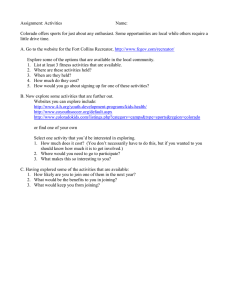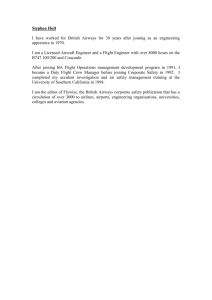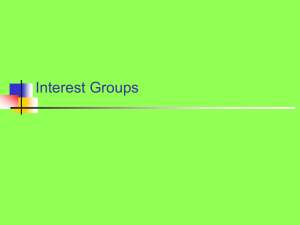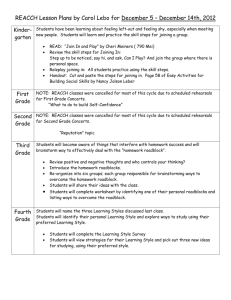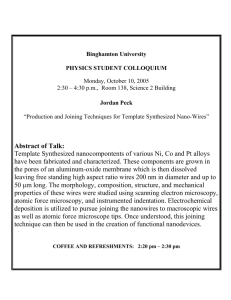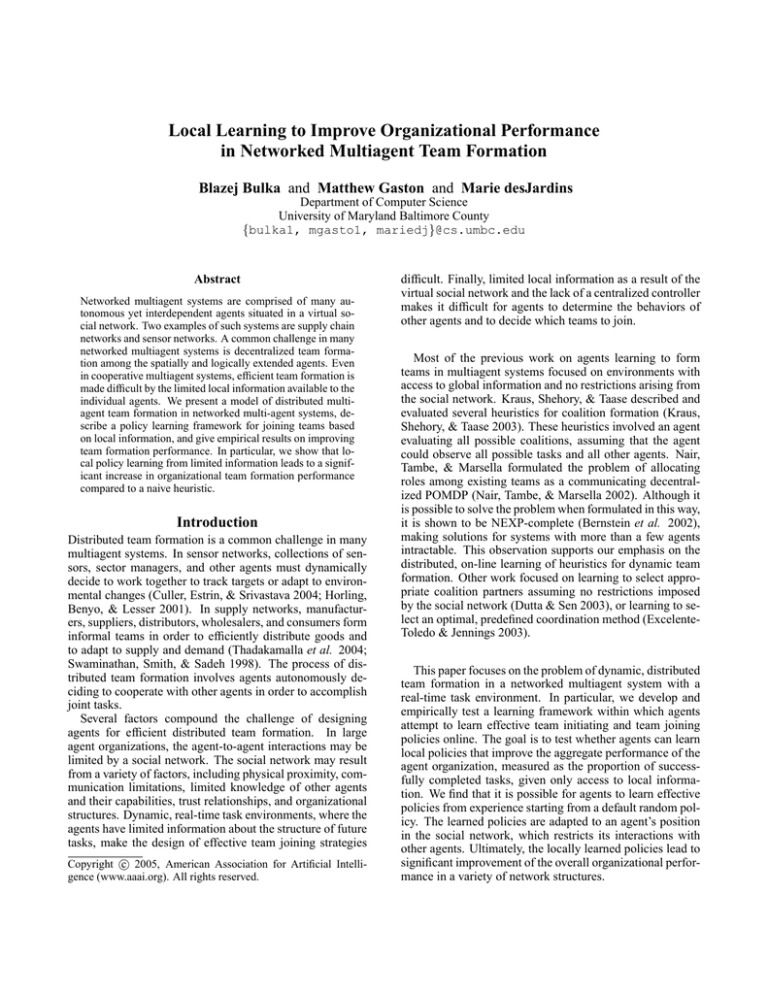
Local Learning to Improve Organizational Performance
in Networked Multiagent Team Formation
Blazej Bulka and Matthew Gaston and Marie desJardins
Department of Computer Science
University of Maryland Baltimore County
{bulka1, mgasto1, mariedj}@cs.umbc.edu
Abstract
Networked multiagent systems are comprised of many autonomous yet interdependent agents situated in a virtual social network. Two examples of such systems are supply chain
networks and sensor networks. A common challenge in many
networked multiagent systems is decentralized team formation among the spatially and logically extended agents. Even
in cooperative multiagent systems, efficient team formation is
made difficult by the limited local information available to the
individual agents. We present a model of distributed multiagent team formation in networked multi-agent systems, describe a policy learning framework for joining teams based
on local information, and give empirical results on improving
team formation performance. In particular, we show that local policy learning from limited information leads to a significant increase in organizational team formation performance
compared to a naive heuristic.
Introduction
Distributed team formation is a common challenge in many
multiagent systems. In sensor networks, collections of sensors, sector managers, and other agents must dynamically
decide to work together to track targets or adapt to environmental changes (Culler, Estrin, & Srivastava 2004; Horling,
Benyo, & Lesser 2001). In supply networks, manufacturers, suppliers, distributors, wholesalers, and consumers form
informal teams in order to efficiently distribute goods and
to adapt to supply and demand (Thadakamalla et al. 2004;
Swaminathan, Smith, & Sadeh 1998). The process of distributed team formation involves agents autonomously deciding to cooperate with other agents in order to accomplish
joint tasks.
Several factors compound the challenge of designing
agents for efficient distributed team formation. In large
agent organizations, the agent-to-agent interactions may be
limited by a social network. The social network may result
from a variety of factors, including physical proximity, communication limitations, limited knowledge of other agents
and their capabilities, trust relationships, and organizational
structures. Dynamic, real-time task environments, where the
agents have limited information about the structure of future
tasks, make the design of effective team joining strategies
c 2005, American Association for Artificial IntelliCopyright gence (www.aaai.org). All rights reserved.
difficult. Finally, limited local information as a result of the
virtual social network and the lack of a centralized controller
makes it difficult for agents to determine the behaviors of
other agents and to decide which teams to join.
Most of the previous work on agents learning to form
teams in multiagent systems focused on environments with
access to global information and no restrictions arising from
the social network. Kraus, Shehory, & Taase described and
evaluated several heuristics for coalition formation (Kraus,
Shehory, & Taase 2003). These heuristics involved an agent
evaluating all possible coalitions, assuming that the agent
could observe all possible tasks and all other agents. Nair,
Tambe, & Marsella formulated the problem of allocating
roles among existing teams as a communicating decentralized POMDP (Nair, Tambe, & Marsella 2002). Although it
is possible to solve the problem when formulated in this way,
it is shown to be NEXP-complete (Bernstein et al. 2002),
making solutions for systems with more than a few agents
intractable. This observation supports our emphasis on the
distributed, on-line learning of heuristics for dynamic team
formation. Other work focused on learning to select appropriate coalition partners assuming no restrictions imposed
by the social network (Dutta & Sen 2003), or learning to select an optimal, predefined coordination method (ExcelenteToledo & Jennings 2003).
This paper focuses on the problem of dynamic, distributed
team formation in a networked multiagent system with a
real-time task environment. In particular, we develop and
empirically test a learning framework within which agents
attempt to learn effective team initiating and team joining
policies online. The goal is to test whether agents can learn
local policies that improve the aggregate performance of the
agent organization, measured as the proportion of successfully completed tasks, given only access to local information. We find that it is possible for agents to learn effective
policies from experience starting from a default random policy. The learned policies are adapted to an agent’s position
in the social network, which restricts its interactions with
other agents. Ultimately, the locally learned policies lead to
significant improvement of the overall organizational performance in a variety of network structures.
A Model of Multiagent Team Formation
To explore simultaneous learning of team joining policies in
a dynamic environment, we have selected a simple multiagent system model, motivated by previous work on agent
team formation (Abdallah & Lesser 2004; Kraus, Shehory,
& Taase 2003; Nair, Tambe, & Marsella 2002). The model
provides a dynamic team formation environment in which
agent teams form spontaneously in a completely decentralized manner and the agents’ decision making is based
solely on local information. In addition, the model allows for potentially very large agent organizations where
the agents are embedded in a social network. The model
is only concerned with the dynamic formation of teams and
not with post-formation teamwork mechanisms or protocols,
for which there is a large body of previous work (Hunsberger & Grosz 2000; Nair, Tambe, & Marsella 2003;
Pynadath & Tambe 2002; Tambe 1997).
In the model, tasks are generated periodically and are
globally advertised to the organization. Agents attempt to
form teams to accomplish these tasks. The agents in the
organization are embedded in a virtual social network that
restricts the set of possible agent teams: specifically, a legal team must be a connected subgraph of the social network. Since we are only concerned with the formation process, tasks are generic in that they only require that a team
of agents with the necessary skills form to accomplish the
specific task.
In this model of team formation, the organization consists
of N agents, A = {a1 , a2 , . . . , aN }, where each agent can
be considered as a unique node in a social network. The social network is modeled as an adjacency matrix E, where an
element of the adjacency matrix eij = 1 if there is an edge
between agent ai and aj and eij = 0 otherwise. The social
relationships among the agents are undirected, or symmetric, so eij = eji . In the agent organization, each agent is
also assigned a single fixed skill, σi ∈ [1, σ], where σ is the
number of different types of skills that are present in the organization. In the experiments presented in this paper, skills
are assigned to each agent uniformly at random from the set
of potential skills.
During the team formation process, each agent can be in
one of three states: UNCOMMITTED, COMMITTED, or AC TIVE . An agent in the UNCOMMITTED state is available and
not assigned to any task. An agent in the COMMITTED state
has selected a task, but the full team to work on the task has
not yet formed. Finally, an agent in the ACTIVE state is a
member of a team that has fulfilled all of the skill requirements for a task and is actively working on that task. Only
uncommitted agents can commit to a new or partially filled
task. Committed agents cannot decommit from a given task.
Upon task completion, agents in the ACTIVE state return to
the UNCOMMITTED state. An agent’s state is denoted si .
Tasks are introduced at fixed task introduction intervals,
where the length of the interval between tasks is given by
the model parameter, µ. Tasks are globally advertised (i.e.,
announced to all agents). Each task Tk has an associated
size requirement, |Tk |, and a |Tk |-dimensional vector of required skills, RTk . The skills required for a given task Tk are
chosen uniformly with replacement from [1, σ]. Each task is
advertised for a finite number of time steps γ, ensuring that
the resources (i.e., agents) committed to the tasks are freed
if the full requirements of the task cannot be met. That is,
if a task is advertised for more than γ time steps without a
full team forming, the agents committed to the task return to
the UNCOMMITTED state. Similarly, teams that successfully
form to fill the requirements of a given task are only active
for a finite number of time steps α.
Agent Social Networks Since we are primarily interested
in large agent organizations where the control of the agents
does not necessarily fall under a single authority, we explicitly model the agent social network. Real-world constraints
such as cognitive limitations, geographical considerations,
and limited communication capabilities make it impossible
for an individual agent to know about or communicate with
all other agents. In our team formation model, the agent social network explicitly restricts the sets of agents that can
form teams.
Definition 1 A valid team is a set of agents M = {ai } that
induce a connected subgraph of the agent social network
and whose skill set {σi } fulfills the skill requirements for
task Tk .
The requirement of a team to induce a connected subgraph
of the agent social network means that for each agent in the
team, ai ∈ M , there must exist at least one other agent,
aj ∈ M, i 6= j, such that eij = 1. This implies that an agent
satisfying skill requirements is only eligible to commit to a
task in two situations: 1) when no other agents are committed to the task, or 2) when at least one neighbor of the agent
is already committed to the task. In essence, this requires
that an agent on a team must “know” at least one other agent
on the team.
Previous work on networked multi-agent team formation
has demonstrated that the ability of an organization of agents
to effectively form teams depends heavily on the structure
of the agent social network (Gaston & desJardins 2003). In
particular, networks with short average path length and hublike structures support a diverse set of possible teams and,
therefore, a large number of task configurations. We have
also explored, given the dependence of team formation performance on network structure, policies for adapting the network structure as a means of improving performance. In this
paper, however, we embed the agents in fixed network structures and focus on the ability of individual agents to learn
effective team joining policies.
Team Formation Policies During each iteration of the
model, the agents receive advertisements about the current
tasks in the system. Each agent with si = UNCOMMITTED
considers all currently advertised tasks for which it is eligible and selects at most one of them. If the selected task
has no other agents committed to it, an agent initiates a
new team; otherwise, it joins the existing team. We refer
to an agent’s strategy for selecting teams to initiate as the
agent’s team initiation policy. The strategy for joining existing teams is termed the agent’s team joining policy.
The policies for initiating and joining teams are an important factor in the performance of multiagent team formation. There are many possibilities for these policies. One
simple policy involves an agent always trying to commit to
a task by randomly selecting from all tasks for which the
agent is eligible. Such a policy, which combines team initiation and team joining, may create unnecessarily high demand on, or inefficient use of, the resources in the system
(e.g., agents may commit to tasks for which it is impossible
for a team to form). Another simple policy, which may place
less burden on the agents, is a policy in which agents commit to tasks with a given probability that depends in a fixed
way on local information, such as the relative percentage of
positions filled. We are interested in designing agents that
autonomously learn effective team formation policies to improve organizational performance. Our framework for learning team joining and team initiating policies is discussed below (Learning to Initiate and Join Teams).
In our experiments, we use as a lower baseline the random policy, which selects uniformly from all of the tasks it
is eligible for, including a virtual wait task. Let E denote
the number of tasks for which an agent is eligible. An agent
using the random policy selects from the eligible tasks (including the wait task) with probability
1
P (Ji ) =
,
(1)
E+1
where Ji is the act of committing to the ith eligible task.
The purpose of the wait task is to prevent agents from always committing to a team at the first opportunity, since doing so may not necessarily be the best option. Although the
random policy is quite simple, we have found it to outperform other more sophisticated hand-designed strategies for
over-constrained networked team formation environments.
Organizational Performance We measure the team formation performance of the agent organization as the ratio of
number of teams successfully formed to the total number of
tasks introduced to the system:
#of teams successfully formed
(2)
org. performance =
#of tasks introduced
This measure of performance provides a global measure of
the effectiveness of the agent organization in forming teams
to execute the advertised tasks. The value of the measure is
comparable only for environments with the same task load.
An increase of the number of tasks above the theoretical
maximum (imposed by the number of agents and network
shape) causes the value to be low, even when the agents’
actions are optimal. In our experiments on learning team
joining and team initiating policies, we are only concerned
with cooperative agents that share the collective goal of improving organizational performance. In the following section, we describe a framework for individual agents to learn
effective team formation policies and discuss the challenges
associated with distributed simultaneous learning.
Learning to Initiate and Join Teams
Rather than designing specific team formation policies for
agents, mechanisms for the individual learning of effective
team joining and team initiating policies allow the agents
and the organization to deal with variability in the team formation environment, including task structure and network
structure (e.g., node failure). Moreover, in many network
structures, the agents have diverse patterns of connectivity
with the rest of the organization. It is difficult to specify team joining policies for all possible positions in a social network—for example, a hub agent with many connections may need a different policy than a “fringe” agent with
only one or two connections—so learning to effectively join
teams given any position in the network is extremely useful.
In order to capture a realistic team formation environment, agents are forced to make decisions based solely on
local information. Any access to global data would require
either extensive communication among agents or a centralized point in the system. Moreover, relying only on local information, reduces the computational burden on the agents.
Some of the key challenges involved in multiagent learning in a distributed team formation environment include:
• Decisions based solely on local information: Each
agent must make decisions about joining teams, initiating teams, or waiting given only partial information about
the state of the organization. The information is limited
by the position of the agent in the social network and by
the dynamic nature of the environment (i.e., an agent cannot know what tasks will be introduced to the system in
the near future).
• Local policy interference: The policies of two nearby
agents (e.g., neighbors or neighbors of neighbors) can interfere with each other when the agents attempt to select
teams to initiate and join. For example, one agent may
learn to join teams only when a specific neighbor is UN COMMITTED (hoping that the UNCOMMITTED neighbor
will subsequently join the team), while the neighbor may
learn to avoid teams of which the first agent is a member.
Moreover, interference can propagate through the agent
organization. We observed this problem to be common in
simultaneous interdependent adaptation.
• Learning to wait: In the dynamic team formation environment, it may be in an agent’s best interest to delay,
rather than committing to any task for which the agent
is eligible. However, the reward for waiting is necessarily
delayed, making it difficult to explicitly learn to wait. Additionally, the value of deciding to wait is dependent upon
the actions of an agent’s neighbors (and, indirectly, on the
rest of the agent network).
• Blocking: If agents are strictly greedy and attempt to join
as many successful teams as possible, blocking may increase. Blocking occurs when an agent is in the COMMITTED or ACTIVE state, preventing teams from forming in
that part of the network structure. This phenomenon is
similar to a bottleneck in a flow network. It is desirable
for agents to learn to prevent or reduce blocking.
• Local performance 6= global performance: If the agents
in the organization attempt to naively optimize local performance (i.e., join as many successful teams as possible),
global performance is not necessarily optimized. One
“greedy” agent can reduce the performance of all of its
neighbors, by making poor task choices or “stealing” skill
slots on a specific task, resulting in lower collective performance.
Many of these challenges are interdependent, manifesting
themselves simultaneously in the dynamic team formation
environment.
The Learning Framework In our team formation model,
the agents receive advertisements of tasks for which they are
eligible during each iteration. The agents decide whether
to initiate or join a team based on the currently advertised
tasks and on the locally perceived state of the agent organization. The agents also try to learn effective team joining
and team initiating policies in real time based on their previous experiences. Whenever an agent decides to join a team,
it records the current state of its environment, including the
state of the team and the states of its neighbors. Later, when
it is known whether the team formed successfully or failed to
form within the time limit, this stored state is used to create
a training instance. The instance is labeled as JOIN or IGNORE, based on the success or failure of the team, respectively. Subsequently, the learning model is updated using
these training instances to influence future team formation
decisions.
A training instance includes the following attributes of an
agent’s local environment: the states of each of the neighbors; the skills of each of the neighbors; the number of unfilled slots in the task; the skills required for the task; and the
amount of time that the task has been advertised. The information about the skills required for a task includes whether
each of the σ skills is not required for this task, required but
already filled, or required but not filled.
In our learning framework, the agents use two sets of classifiers: one for team initiation and another for joining existing teams. The decision to use two classifiers was based on
the fact that initiating a team and joining a partially filled
team are very different situations. For example, joining a
team that already has most of its skill slots filled should have
a greater probability of success than joining a team with
mostly empty skill slots. However, if all agents only join
nearly full teams, then overall organizational performance
would suffer, since agents would never initiate new teams.
The knowledge summarized in a classifier may become
outdated over time, because the neighboring agents also
learn and change their behavior. This creates a need to discard old experience that does not reflect the current situation.
We solved this problem using a simple incremental learning
scheme. We maintain two classifiers for team initiation and
two classifiers for team joining. One of the two classifiers
– the decision classifier – is considered to be sufficiently
trained and is used to make current decisions. While it is being used, the decision classifier is also updated in real time
as training instances are created. The second classifier – the
classifier-in-training – is not used to make decisions until it
becomes well trained, which occurs after a certain number
of time steps. At that point, the existing decision classifier
is discarded and replaced with the classifier-in-training, and
the agent creates a new classifier-in-training. This framework for swapping classifiers ensures that agents are making
decisions based on their most recent experiences.
We used the WEKA library (Witten & Frank 2000) to provide the actual implementation of the classifiers. Initially,
we experimented with a range of classifiers but finally we
selected Naı̈ve Bayes (Domingos & Pazzani 1997) as our
classifier of choice because of its ability to be updated with
new learning instances in real time, its simplicity, and its
performance.
Agents decide which tasks to join by consulting their decision classifiers. For each available task, an agent creates
a testing instance related to the task. Using Naı̈ve Bayes,
these testing instances (i.e., all eligible tasks) are assigned a
probability of success, fi , by the appropriate decision classifier. The agent randomly selects a task to commit to based
on the probabilities of success. The probability P (Ji ) of selecting a task Ji is proportional to its estimated probability
of success.
fi
P (Ji ) = P
i
fi
(3)
Additionally, if the success probabilities of all eligible tasks
sum to less than one, the
Pagent adds a virtual wait task with
probability equal to 1− i fi . The wait task allows the agent
to delay taking action if current conditions are unfavorable,
meaning that no current task is likely to be completed.
Initially, the agents have insufficient experience to make
sensible decisions. As a result, the agents usually estimate
task success probabilities as very low. Because of this, no
teams would be joined, no experience gathered, and a vicious cycle of inexperience would ensue. To avoid this form
of “learned helplessness,” agents always switch to using the
random policy after periods of inactivity. We denote the
length of this period of inactivity as the idleness limit. If
an agent exceeds its idleness limit (i.e., it does not attempt
to join a team for a specified amount of time), it reverts to
selecting a task to join at random.
Filtering Negative Instances Since we focus on heavily
loaded task environments, most of the agents see far more
team failures than successes. If this is not taken into account, the perceived task success probability may drop. As
a result, the agents will quickly stop joining any teams (unless forced by the idleness limit) and the performance will
degrade below that of the random policy. In order to avoid
this difficulty, we introduced filtering, or sampling, of negative training instances. In our learning framework, negative
training instances are filtered if the ratio of positive training
instances to negative training instances is too low. Specifically, a negative training instance will be kept with probability pacc , where
#of positive instances
. (4)
pacc = min 1.0, 2 × r ×
#of all instances
The ratio r determines the acceptance rate of negative instances.
Results
Comparison of global performance
0.25
0.2
Global performance
The goal of our experiments was to determine if it is possible
for agents to learn effective team joining and team initiating
policies. We also wished to evaluate the ability of the agents
to learn, independently of the agent social network. That is,
the goal was to develop and test a learning framework for
an agent embedded in an arbitrary network structure. In that
light, we tested our approach in a variety of commonly used
and realistic network structures: random graphs (Erdos &
Renyi 1959), scale-free graphs (Albert & Barabási 2002),
regular graphs (lattices), and small-world networks (Watts
& Strogatz 1998).
0.15
0.1
0.05
Learned strategy
Random strategy
0
0
5
10
15
20
Time (in thousands of iterations)
Experimental Design In order to evaluate our learning
framework, we ran simulations of the team formation model
with the agents embedded in various social network structures. All of our experiments were in agent societies that
consisted of 100 agents connected in a social network with
approximately 400 edges. We generated 10 such network
structures from each of the four network classes: lattice,
small-world, random, and scale-free.
We ran a series of simulations on each of the network
structures with the agents using the random policy to initiate
and join teams, and a second series with the agents learning
team formation policies in real time. Each simulation was
run for 20,000 time steps. In all simulations, σ = 10 and
|Tk | = 10. A new task was introduced to the system every
time step (µ = 1) and a task was advertised for up to 10 time
steps (γ = 10). Once a task began execution, it executed for
10 time steps (α = 10). Given this environment, an agent
could receive at most ten simultaneous task advertisements
(a task rich environment; because of the restrictions imposed
by the shape of network, agents were not capable of executing all tasks introduced).
The idleness limit was set to 30; i.e., learning agents were
forced to join some team after 30 time steps without attempting to join any teams. The classifiers were trained for 2000
iterations before they were used as decision classifiers (except for the classifiers at the beginning of the simulation),
and the negative instances were filtered with ratio r = 0.1
(see Equation 4). These parameters were determined experimentally. A lower idleness limit led to situations where
agents rarely joined teams. A higher limit led to a situation
where agents perceived that their neighbors were not willing
to join teams, and therefore they also declined to join (especially at the beginning of the simulation, when the classifiers
were yet untrained). Similarly, a shorter training duration for
the classifiers caused poor decisions (too few positive training instances), and a longer training time made some of the
agent’s experience outdated.
Comparison of Strategies We found that agents were
able to learn effective team formation policies (compared to
the random policy), regardless of the underlying social network structure. In all of the networks, the learned policies
significantly outperformed the random policy. The average
results over all networks are presented in Figure 1. The error bars show the 95% confidence interval for each measure-
Figure 1: Average performance.
ment. The agents consistently improved their performance
over the first 5000 time steps. This gain in performance can
be explained by the agents’ use of accumulated experience.
Moreover, there is a visible increase between 4000 and 5000
time steps; this is because at the 4000th iteration, the agents
started to use a new decision classifiers that did not incorporate “experience” gained during the initial period (0–2000
time steps). It is beneficial to discard the experience from
the initial period because during that period, agents’ decisions are more random and inefficient.
We also found that the improved performance of the
learned strategy did not increase the average number of team
joining attempts over that of the random policy. This result
suggests that the learned strategies were also able to effectively decide when to wait, and were able to choose tasks
that were more likely to succeed when they did join teams.
Discussion The results of our simulation show that the
agent community ultimately learned how to coordinate their
team formation decisions. We observed that the agents
sometimes effectively “partition” the network into areas,
depending on the current conditions, so that agents from
one area do not interfere with forming teams from another
area. The agents also developed different joining policies
that were sensitive to their varying positions in the network.
Moreover, the fact that the number of joining attempts did
not increase despite the improved performance indicates that
agents learned to wait more efficiently. That is, agents do not
block other agents with a higher probability of success from
joining if they perceive that the conditions are unfavorable.
Although the learned strategy always achieved higher performance than the random strategy, the performance for both
strategies also varied depending on the underlying network
structure. The values for organizational performance qualitatively matched previously reported results (Gaston & desJardins 2003). Figure 2 shows the average performance of
the learned strategies compared to the random policy for
each of the network structures. For all network structures,
the agents that learned were able to increase organizational
performance, demonstrating that it is possible to learn, independent of the social network topology.
Comparison of global performance
Comparison of global performance
0.25
Comparison of global performance
0.25
Comparison of global performance
0.3
0.25
0.25
0.05
0.15
0.1
Global performance
0.1
0.2
Global performance
0.2
Global performance
Global performance
0.2
0.15
0.2
0.15
0.1
0.05
0.15
0.1
0.05
0.05
Learned strategy
Random strategy
Learned strategy
Random strategy
0
Learned strategy
Random strategy
0
0
5
10
15
20
Time (in thousands of iterations)
5
10
15
Time (in thousands of iterations)
(a) lattice
Learned strategy
Random strategy
0
0
(b) small-world
20
0
0
5
10
15
20
0
5
Time (in thousands of iterations)
(c) random
10
15
20
Time (in thousands of iterations)
(d) scale-free
Figure 2: Average organizational performance for each of the four network structures.
Conclusion and Future Work
We have demonstrated that agents can learn efficient and
effective policies for joining and initiating teams in a realtime, heavily loaded task environment. Additionally, our
learning framework allows the agents to significantly improve organizational performance in a wide variety of network structures.
In the future, we plan to further investigate the use of various machine learning techniques in our learning framework.
In particular, we are exploring the use of more sophisticated
windowing and ensemble techniques for online learning, as
well as mechanisms for learning from imbalanced data sets.
It would be useful for the designers of agents for large-scale
multiagent systems to understand the trade-offs among different learning techniques for team formation and the impact of these techniques on organizational performance and
individual agent policies. We also plan to conduct a more
in-depth study of the policies that agents learn, with a particular focus on comparing the learned strategies for various
social network structures and for different positions within
these structures.
References
Abdallah, S., and Lesser, V. 2004. Organization-based
cooperative coalition formation. In Proceedings of the
IEEE/WIC/ACM International Conference on Intelligent
Agent Techonology (IAT).
Albert, R., and Barabási, A. 2002. Statistical mechanics of
complex networks. Review of Modern Physics 99(3):7314–
7316.
Bernstein, D. S.; Givan, R.; Immerman, N.; and Zilberstein, S. 2002. The Complexity of Decentralized Control
of Markov Decision Processes. Mathematics of Operations
Research 27(4):819–840.
Culler, D.; Estrin, D.; and Srivastava, M. 2004. Overview
of sensor networks. IEEE Computer 37(8):41–19.
Domingos, P., and Pazzani, M. 1997. On the optimality
of the simple Bayesian classifier under zero-one loss. Machine Learning 29:103–130.
Dutta, S., and Sen, S. 2003. Forming stable partnerships.
Cognitive Systems Research 4(3):211–221.
Erdos, P., and Renyi, A. 1959. On random graphs. Publicationes Mathematicae (6):290–297.
Excelente-Toledo, C. B., and Jennings, N. R. 2003. Learning when and how to coordinate. Web Intelligence and
Agent System 1(3 - 4):203–218.
Gaston, M., and desJardins, M. 2003. Team formation in
complex networks. In Proceedings of the 1st NAACSOS
Conference.
Horling, B.; Benyo, B.; and Lesser, V. 2001. Using self
diagnosis to adapt organizational structure. In Proceedings
of the 5th International Conference on Autonomous Agents.
Hunsberger, L., and Grosz, B. 2000. A combinatorial
auction for collaborative planning. In Proceedings of the
Fourth International Conference on Multi-Agent Systems
(ICMAS-2000).
Kraus, S.; Shehory, O.; and Taase, G. 2003. Coalition
formation with uncertain heterogeneous information. In
Proceedings of the Second International Joint Conference
on Autonomous Agents and Multiagent Systems (AAMAS
’03).
Nair, R.; Tambe, M.; and Marsella, S. 2002. Team formation for reformation. In Proceedings of the AAAI Spring
Symposium on Intelligent Distributed and Embedded Systems.
Nair, R.; Tambe, M.; and Marsella, S. 2003. Role allocation and reallocation in multiagent teams: Towards a
practical analysis. In Proceedings of the Second International Joint Conference on Agents and Multiagent Systems
(AAMAS).
Pynadath, D., and Tambe, M. 2002. Multiagent teamwork:
Analyzing the optimality and complexity of key theories
and models. In Proceedings of the International Conference on Autonomous Agents and Multiagent Systems (AAMAS ’02).
Swaminathan, J. M.; Smith, S. F.; and Sadeh, N. M. 1998.
Modeling supply chain dynamics: A multiagent approach.
Decision Sciences 29(3):607–632.
Tambe, M. 1997. Towards flexible teamwork. Journal of
Artificial Intelligence Research 7:83–124.
Thadakamalla, H. P.; Raghaven, U. N.; Kumera, S.; and
Albert, R. 2004. Survivability of multiagent-based supply networks: A topological perspective. IEEE Intelligent
Systems 19(5):24–31.
Watts, D., and Strogatz, S. 1998. Collective dynamics of
‘small-world’ networks. Nature 393:440–442.
Witten, I. H., and Frank, E. 2000. Data Mining: Practical Machine Learning Tools with Java Implementations.
Morgan Kaufmann.

